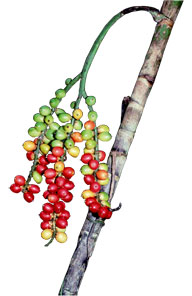- Acanthophoenix
- Acrocomia
- Actinokentia
- Actinorhytis
- Adonidia
- Aiphanes
- Allagoptera
- Ammandra
- Aphandra
- Archontophoenix
- Areca
- Arenga
- Asterogyne
- Astrocaryum
- Attalea
- Bactris
- Balaka
- Barcella
- Basselinia
- Beccariophoenix
- Bismarckia
- Borassodendron
- Borassus
- Brassiophoenix
- Burretiokentia
- Butia
- Calamus
- Calyptrocalyx
- Calyptrogyne
- Calyptronoma
- Carpentaria
- Carpoxylon
- Caryota
- Ceratolobus
- Ceroxylon
- Chamaedorea
- Chamaerops
- Chambeyronia
- Chelyocarpus
- Chuniophoenix
- Clinosperma
- Coccothrinax
- Cocos
- Corypha
- Cryosophila
- Cyphokentia
- Cyphophoenix
- Cyphosperma
- Daemonorops
- Deckenia
- Desmoncus
- Dictyocaryum
- Drymophloeus
- Dypsis
- Elaeis
- Eleiodoxa
- Eremospatha
- Eugeissona
- Euterpe
- Gaussia
- Geonoma
- Guihaia
- Hedyscepe
- Hemithrinax
- Howea
- Hyophorbe
- Hyospathe
- Hyphaene
- Iriartea
- Iriartella
- Itaya
- Jailoloa
- Johannesteijsmannia
- Juania
- Jubaea
- Jubaeopsis
- Kentiopsis
- Kerriodoxa
- Korthalsia
- Laccospadix
- Laccosperma
- Lanonia
- Latania
- Lemurophoenix
- Leopoldinia
- Lepidocaryum
- Lepidorrhachis
- Leucothrinax
- Licuala
- Linospadix
- Livistona
- Lodoicea
- Lytocaryum
- Manicaria
- Manjekia
- Marojejya
- Masoala
- Mauritia
- Mauritiella
- Maxburretia
- Medemia
- Metroxylon
- Myrialepis
- Nannorrhops
- Nenga
- Neonicholsonia
- Neoveitchia
- Nephrosperma
- Normanbya
- Nypa
- Oenocarpus
- Oncocalamus
- Oncosperma
- Orania
- Oraniopsis
- Parajubaea
- Pelagodoxa
- Phoenicophorium
- Phoenix
- Pholidocarpus
- Pholidostachys
- Physokentia
- Phytelephas
- Pigafetta
- Pinanga
- Plectocomia
- Plectocomiopsis
- Podococcus
- Pogonotium
- Ponapea
- Prestoea
- Pseudophoenix
- Ptychococcus
- Ptychosperma
- Raphia
- Ravenea
- Reinhardtia
- Retispatha
- Rhapidophyllum
- Rhapis
- Rhopalostylis
- Roscheria
- Roystonea
- Sabal
- Sabinaria
- Salacca
- Saribus
- Satakentia
- Satranala
- Schippia
- Sclerosperma
- Socratea
- Solfia
- Sommieria
- Syagrus
- Synechanthus
- Tahina
- Tectiphiala
- Thrinax
- Trachycarpus
- Trithrinax
- Veitchia
- Verschaffeltia
- Voanioala
- Wallaceodoxa
- Wallichia
- Welfia
- Wendlandiella
- Wettinia
- Wodyetia
- Zombia
- x Jubautia splendens
- ?? Acoelorrhaphe
- ?? Bentinckia
- ?? Brahea
- ?? Clinostigma
- ?? Colpothrinax
- ?? Copernicia
- ?? Cyrtostachys
- ?? Dictyosperma
- ?? Dransfieldia
- ?? Heterospathe
- ?? Hydriastele
- ?? Iguanura
- ?? Incertae sedis & excluded names
- ?? Loxococcus
- ?? Micronoma
- ?? Paripon
- ?? Pritchardia
- ?? Rhopaloblaste
- ?? Serenoa
- ?? Washingtonia
What is Palmweb?
 Palmweb is an on-line palm encyclopaedia . It contains information on all ca. 2,585 species and 188 genera of palms that has been gleaned primarily from taxonomic publications. It is structured around a checklist of palm names (including synonyms) provided by the World Checklist of Monocotyledons at the Royal Botanic Gardens, Kew. You will find a page (a taxon page) for every genus and species of palm in Palmweb.
Palmweb is an on-line palm encyclopaedia . It contains information on all ca. 2,585 species and 188 genera of palms that has been gleaned primarily from taxonomic publications. It is structured around a checklist of palm names (including synonyms) provided by the World Checklist of Monocotyledons at the Royal Botanic Gardens, Kew. You will find a page (a taxon page) for every genus and species of palm in Palmweb.
Exploring Palmweb
You can use Palmweb to access taxon pages on Palmweb, by browsing the taxon tree or searching for a scientific name, using the tools on the left side of the screen. The tree shows only currently accepted names, but it is possible to search using synonyms using the search function . The advanced search allows you to search by name (scientific, common, accepted, synonym) and/or by geographical region.
What will you find?
Palmweb includes:
1. the current nomenclature and synonymy of palms
2. morphological descriptions for over 40% of palm species and 100% of genera, with additional information where available on biology, ecology, conservation, uses, common names, specimen citations and other topics.
3. distribution maps for all genera and species to TDWG (Taxonomic Database Working Group) level 3
4. images for more than 30% of species
5. a glossary of palm terms
6. a bibliography
7. interactive identification keys
8. original places of publication for over 60% of accepted names
9. quick search tools for exploring other databases such as Flickr, Google Images, Genbank, GBIF and the Biodiversity Heritage Library.
10. protologues for many synonyms (although our focus is on compiling data for currently accepted taxa)
Some technical details
The database underlying Palmweb follows a data model called the Common Data Model (CDM) created by EDIT developers at the Botanischer Garten und Botanisches Museum in Berlin. This database and the portal that delivers the Palmweb content are part of the Platform for Cybertaxonomy, a set of tools designed to aid taxonomists in doing their research.

